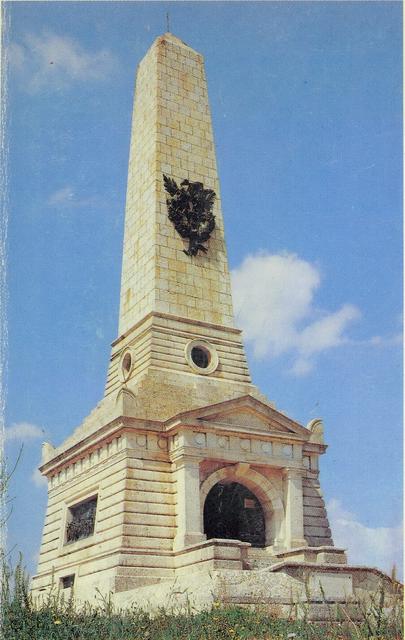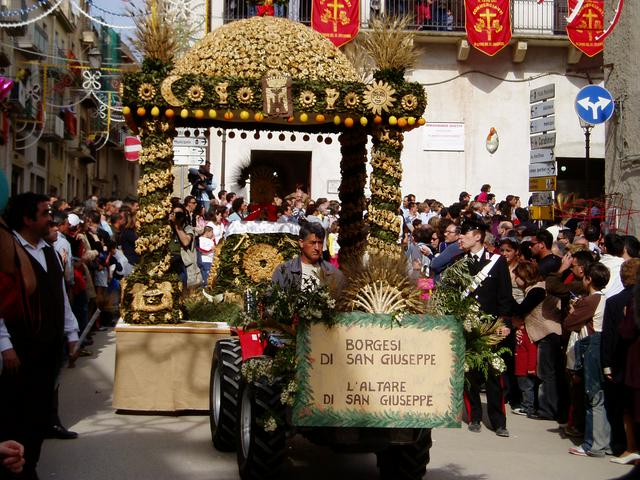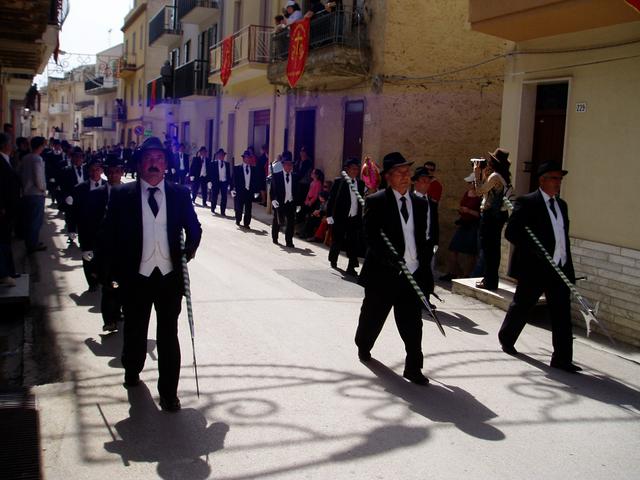Calatafimi Segesta is in Sicily.
The town takes its name from the Arab "Qal’at Fimi" (that is Rock of Eufemio): he was an officer of Byzantium who, according to an old tradition, favoured the conquest of Sicily by the Saracens. Some scholars link the name Calatafimi with Acesta, a little town contemporary of Segesta, or with Castrum Phimes, from the name of a noble landowner of Segesta, named also by Cicero. The present town originated around the “Castle of Phimes”, and its oldest part stands here. Calatafimi, with the Castle of Eufemio and its churches, is characterised also by its lanes and small streets of Arab derivation. At about 10 km from this town there is the archaeological site of Segesta, with the Greek temple and the ancient theatre, where they hold classical performances.
- Ufficio Turistico, piazza Cangemi,1, +39 0924 9505507.
- Pro Loco, Corso Vittorio Emanuele,16, +39 333 9245687.
- U.R.P., Piazza Francesco Cangemi,1, +39 0924 9505240.
Ufficio Turistico, piazza Cangemi,1, +39 0924 9505507.
Pro Loco, Corso Vittorio Emanuele,16, +39 333 9245687.
U.R.P., Piazza Francesco Cangemi,1, +39 0924 9505240.
Segesta is the site of an ancient Graeco-Roman city.
The site is immediately off the main A29 road, straight after a long tunnel if travelling from Palermo. Onsite there is free parking.
Tarantola Bus goes between Palermo and Calatafimi (aka Calatafimi-Segesta) a few times daily, stopping at Segesta en route. You may have a long wait for a return bus. (Perhaps confusingly, Segesta Bus does not go to Segesta.)
Entry to the temple is on foot - about a 5-minute uphill walk. A bus (€1.50) is available every 30 minutes to the site of the Amphitheatre at the top of the hill. It's a brisk, uphill, 20-minute walk otherwise (no entrance fee). Coffee and pizza are well deserved at the cafe near the car park if you walked to the amphitheatre.
There are 3 major sights at this location, and there are other remains from the Roman and medieval periods which are documented by signs in five languages across the site.
- The Doric temple, Archaelogical area of Segesta. Built between 430-420 BCE, 61 m (190 feet) long, 26 m wide, built upon a platform of 4 steps, it has 36 Doric columns supporting the stone roof-frame of the structure (14 columns along the lengths of the building, 6 columns across front and back). They are of a "rough" finish as the temple has never been completed. The temple seems also to have lacked a roof over the cella (main chamber) in antiquity, rather uniquely - scholars are in disagreement as to whether the temple was planned this way, or just never completed. Entry is charged.
- The Greek Amphitheatre. It is on a hilltop and was built by the Greeks at about 400 BC. It was discovered in the 19th century. They play classical comedies and tragedies in July and August.
- The Greek sanctuary, contrada Mango (on the Provincial Road leading to Segesta. In the archaeological area of Segesta there are the remains of an ancient sanctuary, dating back perhaps to the 6th century BC and built outside the town centre of Segesta.
The Doric temple, Archaelogical area of Segesta. Built between 430-420 BCE, 61 m (190 feet) long, 26 m wide, built upon a platform of 4 steps, it has 36 Doric columns supporting the stone roof-frame of the structure (14 columns along the lengths of the building, 6 columns across front and back). They are of a "rough" finish as the temple has never been completed. The temple seems also to have lacked a roof over the cella (main chamber) in antiquity, rather uniquely - scholars are in disagreement as to whether the temple was planned this way, or just never completed. Entry is charged.
The Greek Amphitheatre. It is on a hilltop and was built by the Greeks at about 400 BC. It was discovered in the 19th century. They play classical comedies and tragedies in July and August.
The Greek sanctuary, contrada Mango (on the Provincial Road leading to Segesta. In the archaeological area of Segesta there are the remains of an ancient sanctuary, dating back perhaps to the 6th century BC and built outside the town centre of Segesta.

- Pianto Romano. The Ossuary of Pianto Romano, built in memory of the soldiers who died in the battle between the Mille and the Bourbon troops, from a design made by E. Basile. It was inaugurated on 15 May 1892. From its top you can admire wonderful landscapes in all directions.
- Castello Eufemio. It is on a hill dominating the whole town. It is probably a 12th-century reconstruction of an older castle built for defence. Today there remain only a tower, some warehouses, the cells and the courtyard.
- Chiesa Madre. This church was built in the first half of the 13th century and dedicated to Saint Silvestro the Pope; it was then rebuilt in 1547. It has a nave and two aisles, with Roman arches. There are a lot of stuccoes, paintings, marbles and wooden statues.
- Chiesa del Santissimo Crocifisso. This church was built at about 1750, to G.B. Amico's plan. In the façade there is a portal coming from the former church of Stimmate (Stigmata) in Palermo. Inside you can see frescoes by the painter Gianbecchina, stuccoes and paintings of different periods.
- Chiesa di san Michele, piazza Plebiscito. Founded by the Congregation of Saint Michael in the 14th century and restored by the Third Franciscan Order, who enlarged the adjoining friary. It has a nave with two aisles and is rich with stuccoes, paintings and wooden statues.
- Chiesa di Maria Santissima del Giubino, Via Mazzini. This church adjoins the former Benedictine nunnery and is a very beautiful church. It was built on the plan made by Giovanni Biagio Amico and is dedicated to the cult of Madonna di Giubino, patroness of Calatafimi.
- Santuario di Maria Santissima di Giubino. It is on the northern side of the hill Tre croci. It is a Marian sanctuary linked to the memory of the Blessed Arcangelo Placenza from Calatafimi and to the cult of Maria Santissima di Giubino.
- Itinerario dei vicoli, below via Oberdan. It is like a voyage inside people's history: on the walls of these lanes you can see Garibaldi's deeds again, the farmers' proverbs, the ceramics coloured butterflies and the holy water stoups.
- Museo Etnoantropologico Comunale, Corso Vittorio Emanuele 78, +39 0924 951151, +39 0924-952696. Th-Sa 10:00-14:00, 15:00-19:00. It represents the historical memory and Calatafimi people's vocation which is merely agricultural; you can see implements, tools and objects almost forgotten now, which were used in the fields, by artisans or in the houses. Free.
- Casa-Museo di Garibaldi, Via Guglielmo Marconi, 25. Th-Sa 10:00-14:00, 15:00-19:00. The building dates back to 1700 and reminds the Garibaldian epic deeds: there are two marble memorial tablets on façade and inside it, dated 16th May 1860 and July 1862. Both of them are testimony of the presence of garibaldi at calatfimi and at the Pampalones' house. Free.
- Ex Convento di San Francesco. The former church, dedicated to saint James the apostle, may have dated back to the 13th century. Today, on the eastern side, there are a window (which is walled up) surmounting a door, with small columns and an archivolt of the 16th century. It was enlarged in 1544 and the interior has been restored at about 1750. It hosts some paintings an wooden statues.
Pianto Romano. The Ossuary of Pianto Romano, built in memory of the soldiers who died in the battle between the Mille and the Bourbon troops, from a design made by E. Basile. It was inaugurated on 15 May 1892. From its top you can admire wonderful landscapes in all directions.
Castello Eufemio. It is on a hill dominating the whole town. It is probably a 12th-century reconstruction of an older castle built for defence. Today there remain only a tower, some warehouses, the cells and the courtyard.
Chiesa Madre. This church was built in the first half of the 13th century and dedicated to Saint Silvestro the Pope; it was then rebuilt in 1547. It has a nave and two aisles, with Roman arches. There are a lot of stuccoes, paintings, marbles and wooden statues.
Chiesa del Santissimo Crocifisso. This church was built at about 1750, to G.B. Amico's plan. In the façade there is a portal coming from the former church of Stimmate (Stigmata) in Palermo. Inside you can see frescoes by the painter Gianbecchina, stuccoes and paintings of different periods.
Chiesa di san Michele, piazza Plebiscito. Founded by the Congregation of Saint Michael in the 14th century and restored by the Third Franciscan Order, who enlarged the adjoining friary. It has a nave with two aisles and is rich with stuccoes, paintings and wooden statues.
Chiesa di Maria Santissima del Giubino, Via Mazzini. This church adjoins the former Benedictine nunnery and is a very beautiful church. It was built on the plan made by Giovanni Biagio Amico and is dedicated to the cult of Madonna di Giubino, patroness of Calatafimi.
Santuario di Maria Santissima di Giubino. It is on the northern side of the hill Tre croci. It is a Marian sanctuary linked to the memory of the Blessed Arcangelo Placenza from Calatafimi and to the cult of Maria Santissima di Giubino.
Itinerario dei vicoli, below via Oberdan. It is like a voyage inside people's history: on the walls of these lanes you can see Garibaldi's deeds again, the farmers' proverbs, the ceramics coloured butterflies and the holy water stoups.
Museo Etnoantropologico Comunale, Corso Vittorio Emanuele 78, +39 0924 951151, +39 0924-952696. Th-Sa 10:00-14:00, 15:00-19:00. It represents the historical memory and Calatafimi people's vocation which is merely agricultural; you can see implements, tools and objects almost forgotten now, which were used in the fields, by artisans or in the houses. Free.
Casa-Museo di Garibaldi, Via Guglielmo Marconi, 25. Th-Sa 10:00-14:00, 15:00-19:00. The building dates back to 1700 and reminds the Garibaldian epic deeds: there are two marble memorial tablets on façade and inside it, dated 16th May 1860 and July 1862. Both of them are testimony of the presence of garibaldi at calatfimi and at the Pampalones' house. Free.
Ex Convento di San Francesco. The former church, dedicated to saint James the apostle, may have dated back to the 13th century. Today, on the eastern side, there are a window (which is walled up) surmounting a door, with small columns and an archivolt of the 16th century. It was enlarged in 1544 and the interior has been restored at about 1750. It hosts some paintings an wooden statues.
- Biblioteca Comunale, Piazza Plebiscito, +39 0924 951071. M-Sa 09:00-13:00; Mar, Gio 16:30-18:00.
- Bosco di Angimbè, National Road 113, S.S.113 (north-east of Calatafimi. The evergreen forests represent an environment full of fashion, not only for the species of their trees, like the cork oak and the holm oak but also for the richness of shrubs and herbaceous plants which develop in the underwood.
- Cavalieri Del Castello Eufemio A.S.D., Contrada Barbaro S.P. 68 (Segesta archaelogical area. Its main activity is the formation of new horse-riding champions who take part in a lot of competitions.
- Scuderia Vivona, Contrada Pantano, +39 339 2878407. It organizes trips and excursions on horses.
- Terme segestane, near the Castellammare del Golfo junction of the National road (S.S.) 113. The establishment has three thermal bathing pools and three sulphuric water springs (two inside and one outside it) that naturally pour out at the temperature of 44° and 46° C. You can carry out an efficient and valuable therapy in these natural warm-damp and sudorific rooms.

- Procession of the Most Holy Crucifix, Church of the Most Holy Crucifix. on 3rd May.
- Garibaldians' Day: on 15th May
- Procession of Corpus Domini, Piazza Plebiscito (near the Town Hall. half June.
- Procession of Our Lady of the Assumption: on 15th August.
- Procession of Madonna del Giubino: on the fourth Sunday of September.
- Procession of the Immaculate Conception: on December 8th (evening and night).
- Estate Calatafimese (Calatafimi's Summer): from the end of July to the first days of September).
- Calatafimi Segesta Dionisiache, Segesta. July-August. A series of classical theatrical performances held in summer.
- Feast of the Most Holy Crucifix, Church of the Most Holy Crucifix. Every 5 years from 1st-3rd May.

Procession of the Most Holy Crucifix, Church of the Most Holy Crucifix. on 3rd May.
Procession of Corpus Domini, Piazza Plebiscito (near the Town Hall. half June.
Calatafimi Segesta Dionisiache, Segesta. July-August. A series of classical theatrical performances held in summer.
Feast of the Most Holy Crucifix, Church of the Most Holy Crucifix. Every 5 years from 1st-3rd May.
Biblioteca Comunale, Piazza Plebiscito, +39 0924 951071. M-Sa 09:00-13:00; Mar, Gio 16:30-18:00.
Bosco di Angimbè, National Road 113, S.S.113 (north-east of Calatafimi. The evergreen forests represent an environment full of fashion, not only for the species of their trees, like the cork oak and the holm oak but also for the richness of shrubs and herbaceous plants which develop in the underwood.
Cavalieri Del Castello Eufemio A.S.D., Contrada Barbaro S.P. 68 (Segesta archaelogical area. Its main activity is the formation of new horse-riding champions who take part in a lot of competitions.
Scuderia Vivona, Contrada Pantano, +39 339 2878407. It organizes trips and excursions on horses.
Terme segestane, near the Castellammare del Golfo junction of the National road (S.S.) 113. The establishment has three thermal bathing pools and three sulphuric water springs (two inside and one outside it) that naturally pour out at the temperature of 44° and 46° C. You can carry out an efficient and valuable therapy in these natural warm-damp and sudorific rooms.
- Banca Don Rizzo Credito Cooperativo, Via Segesta, 66.
- Credito Siciliano, Largo Duca degli Abruzzi 4.
- Unicredit, Via Mazzini 23.
- Ceramiche Maior, via Roma, 24, +39 333 2187158.
- Planet Gems, via Comm. Sebastiano Simone, 36, +39 0924 952944. Mediterranean coral pictures and embellished porcelain.
Banca Don Rizzo Credito Cooperativo, Via Segesta, 66.
Credito Siciliano, Largo Duca degli Abruzzi 4.
Unicredit, Via Mazzini 23.
Ceramiche Maior, via Roma, 24, +39 333 2187158.
Planet Gems, via Comm. Sebastiano Simone, 36, +39 0924 952944. Mediterranean coral pictures and embellished porcelain.
- Divino Rosso, Via A. de Gasperi, +39 340 9434189, +39 339 1556252, +39 339 4622125. Restaurant and pub at fixed menu
- Fridor, Via Aldo Moro, 43, +39 0924 950111. Fry shop and self-service
- La Maison Ristorante, Via Segesta, 15, +39 0924 950006.
- Margana s.a.s., Contrada Margana, +39 338 3293872, +39 334 9116919, +39 338 7208920.
- Pizza in piazza, Piazza Pietro Nocito, 12, +39 0924 952093.
- Pizza Planet, Piazza Duca degli Abruzzi, +39 389 4233331.
- Pizzeria Ristorante dell' Orso, via Gorizia, 2.
- Ristorante Bar, Archaeological area of Segesta, +39 0924 951131.
- Ristorante Mediterraneo Segesta, Turistic Railway Station Segesta (autostrada A29, exit for Segesta, +39 0924 951355, +39 330 832537. restaurant-pizzeria
- Ristorante Mille Pini, Belvedere F. Vivona, 4, +39 0924 951260.
- Ristorante Pizzeria Egesta, via F. Lentini, 65, +39 0924 950367.
- Ristorante Pizzeria Le Gole, via F.Lentini,9, +39 329 1072610. A large choice in the menu: very good appetizers, first courses and meat second courses.
- Trattoria Paninoteca, via Segesta, 55, +39 0924 950095.
Divino Rosso, Via A. de Gasperi, +39 340 9434189, +39 339 1556252, +39 339 4622125. Restaurant and pub at fixed menu
Fridor, Via Aldo Moro, 43, +39 0924 950111. Fry shop and self-service
La Maison Ristorante, Via Segesta, 15, +39 0924 950006.
Margana s.a.s., Contrada Margana, +39 338 3293872, +39 334 9116919, +39 338 7208920.
Pizza in piazza, Piazza Pietro Nocito, 12, +39 0924 952093.
Pizza Planet, Piazza Duca degli Abruzzi, +39 389 4233331.
Pizzeria Ristorante dell' Orso, via Gorizia, 2.
Ristorante Bar, Archaeological area of Segesta, +39 0924 951131.
Ristorante Mediterraneo Segesta, Turistic Railway Station Segesta (autostrada A29, exit for Segesta, +39 0924 951355, +39 330 832537. restaurant-pizzeria
Ristorante Mille Pini, Belvedere F. Vivona, 4, +39 0924 951260.
Ristorante Pizzeria Egesta, via F. Lentini, 65, +39 0924 950367.
Ristorante Pizzeria Le Gole, via F.Lentini,9, +39 329 1072610. A large choice in the menu: very good appetizers, first courses and meat second courses.
Trattoria Paninoteca, via Segesta, 55, +39 0924 950095.
- La pagoda, Piazza Nicolò Mazara, +39 333 590 1023.
La pagoda, Piazza Nicolò Mazara, +39 333 590 1023.
- Vigili Urbani, Via Mazzini, 46, +39 0924 9505280.
- Carabinieri's post, Contrada San Vito,45 (near the end of via De Gasperi, +39 0924 951110.
- Guardia Medica, Via Alcide De Gasperi, 101, +39 950370.
- dottor Minore Leonardo, +39 333 8077716. ambulatory veterinarian
- Farmacia Autuori, Via A. De Gasperi, 48, +39 0924 951184.
- Farmacia D' Angelo Francesca, Corso V. Emanuele, 51, +39 0924 951092.
- Farmacia Gallo Antonino, Via Avv. G. Gallo, 1, +39 0924 951178.
Vigili Urbani, Via Mazzini, 46, +39 0924 9505280.
Carabinieri's post, Contrada San Vito,45 (near the end of via De Gasperi, +39 0924 951110.
Guardia Medica, Via Alcide De Gasperi, 101, +39 950370.
dottor Minore Leonardo, +39 333 8077716. ambulatory veterinarian
Farmacia Autuori, Via A. De Gasperi, 48, +39 0924 951184.
Farmacia D' Angelo Francesca, Corso V. Emanuele, 51, +39 0924 951092.
Farmacia Gallo Antonino, Via Avv. G. Gallo, 1, +39 0924 951178.
- Poste Italiane, Via Segesta, 2, +39 0924 954811. Mon-Fri 8:30-13:30, Sat 8:30-12:30.
- L'angolo dello Sport, Corso Garibaldi, 23, +39 0924 954367.
- Internet Point, Piazza Nocito, 12, +39 0924 954319.
Poste Italiane, Via Segesta, 2, +39 0924 954811. Mon-Fri 8:30-13:30, Sat 8:30-12:30.
L'angolo dello Sport, Corso Garibaldi, 23, +39 0924 954367.
Internet Point, Piazza Nocito, 12, +39 0924 954319.
- Segesta
- Nature reserve Bosco di Alcamo
- Alcamo
- Castellammare del Golfo
- Salemi
- Erice
